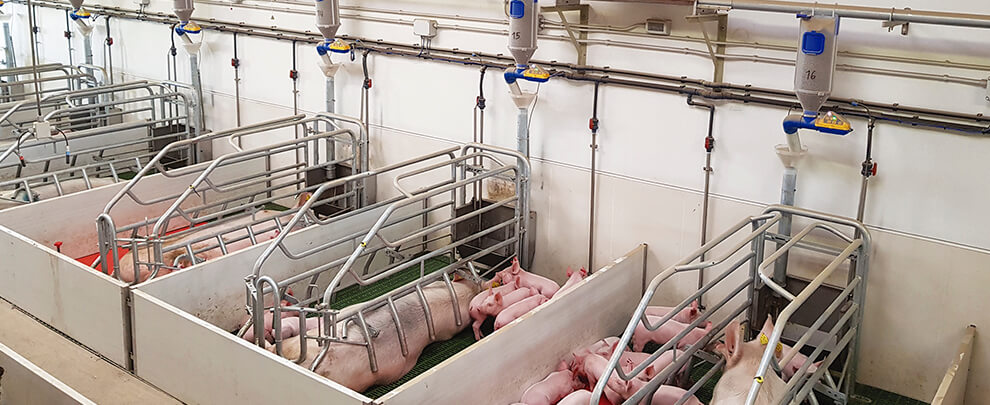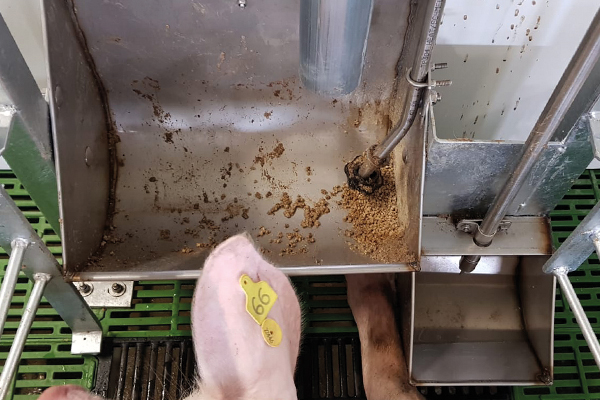Blog
Blog

How can we manage the water consumption of the sows?
16th February 2021 - Studies
Josep Rius. Rotecna Technician.
There are many feed and water supply systems on the market for lactating sows. Often both elements are offered at the same point: the feeder. One of them, perhaps the most widely used, consists of placing a high-flow trough or pacifier (3-6 litres/minute) inside, which, in turn, is complemented on many occasions with a manual water input (commonly known as "water blow"). In this way, all the amenities are offered so that the animals have adequate access to water.
As a concept, it is a fairly well-resolved system: before offering food, the feeders are checked if there is too much in any of them, the feed is dispensed, and a little more water is provided to the sows that require it. Between meals, you can also add water manually. Disadvantages: good monitoring management of the entire process is necessary every day. It is not easy to find the ideal balance between the water/feed ratio and the amount of water in the feeder when supplying the feed. Sometimes this proportion may be adequate, but in others, it can be unsatisfactory.
However, the situation can still worsen when the feed is dispensed to the sows, and we don't know if they will eat it, which causes an increase in costs due to wasting feed and the work required to clean the feeders before the next feeding. Too often, such tasks have been assumed to be routine on many farms, and the quality of its execution by farm operators depends directly on animals eating and drinking appropriately.
Water and electronic feed dispensers
In recent years, there has been a clear improvement in feed dispensing using electronic dispensers. In many cases, this progress has not gone hand in hand with using a water dispensing system adapted to its needed features. On the one hand, we have dispensers with a large configuration capacity and subsequent verification and, on the other, water systems without any type of control or monitoring. We have been able to be very precise with the feed, but not very much with the water. To obtain an adequate diet, we have to be in both cases and have systems designed for their correct synchronization.
Electronic feeding has favoured that the food can be distributed in different feedings 24 hours a day. This has made the feed portion smaller than conventional metering systems, which substantially reduces the chances of waste and forces better water management in smaller amounts. If you change the way you supply the feed, shouldn't you also change the water supply system?
In the context of the so-called "precision percentage", we focus on the "individual in front of the group". Each animal has different food needs; therefore, it would also be logical to use what technology offers us to meet this need. An electro-valve in each feeder to offer water depending on the feed dispensed and a water supply system outside the feeder is an excellent option because they allow maximizing water consumption and always providing food with the appropriate water/feed ratio.

Example of a trough set with electrovalve and separate water. Photo: Rotecna.
Let's take an example: suppose a sow on the 18th day of lactation has the possibility of eating 9 kg of feed. If the feed/water ratio is from 1 to 2, we offer her 18 litres of water with food, and she has already drunk approximately half of the water she needs for the day. In this way, it is possible to feed with fresh feed and in optimal conditions. It goes without saying that everything that can be offered sows to promote good nutrition will directly affect their health, longevity and well-being. In turn, we make sure that they have all the elements to produce the maximum milk in both quantity and quality and its advantages at the cost level by minimizing waste and cleaning the feeders.
Currently, pig farming already has many ways for animals to eat and drink appropriately. Its benefits are known to everyone, so something so important cannot be left unchecked. There are meters to monitor water on a few farms, although observing its consumption can offer us precious information on animals' health and production. An alteration in water consumption can indicate the early existence of a disease. To conclude, it must be remembered that all systems have installation requirements: it must be ensured that the water flow arrives in optimal conditions at maximum demand times.
What do we know about water?
Water is the primary nutrient of living beings and happens in different processes:
- Nutrient transport.
- Body thermoregulation.
- Elimination of metabolites in the urine.
- In addition to this, it aids digestion and is the main component of milk (80%).
Amounts
- The lactating sows drink averages of 20-25 litres of water/day and consume between 33-38 litres of water a day during the 3 or 4 weeks of lactation.
- To increase the weight of the litter by a kilogram, about 4 litres of milk are necessary.
- To produce 1 litre of milk, 2.5 to 3 litres of water are needed.
- At the lactation peak, a sow can produce 10 to 13 litres of milk daily.
- A sow with a 23-day lactation and an average of 22 litres/day, drinks 506 litres of water.
- The mean water/feed ratio ranges from 3-5 litres of water per kilo of feed. At the beginning of lactation it is higher, reaching 5-7 litres, and then drops to 3-5 litres a week.
Temperature
With high ambient temperatures, sows prefer water 10 degrees lower than water at room temperature, and at most, 10 degrees.






